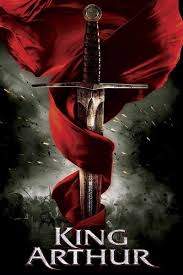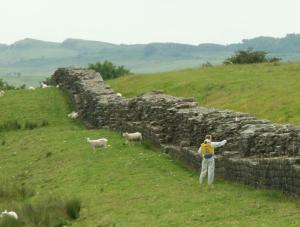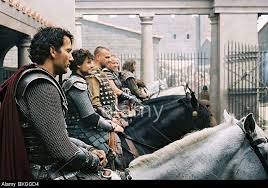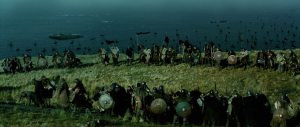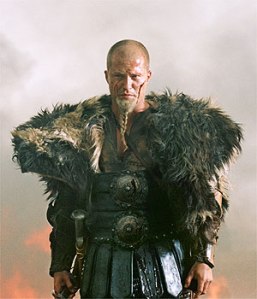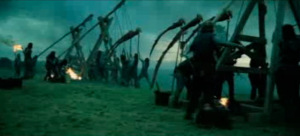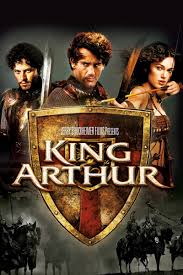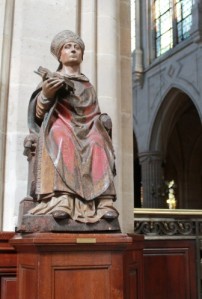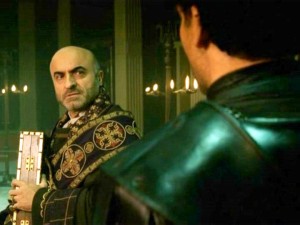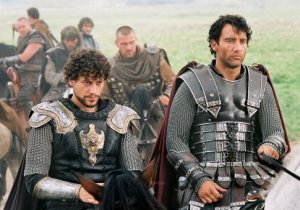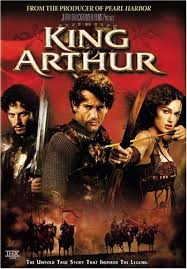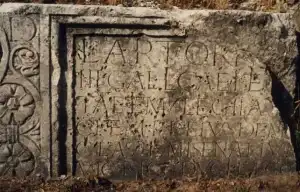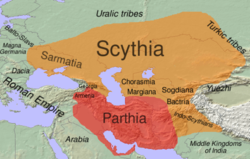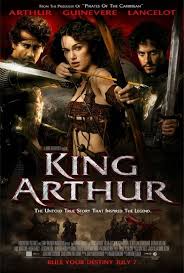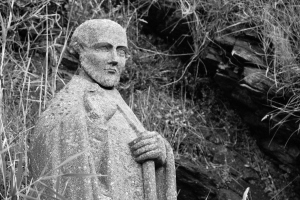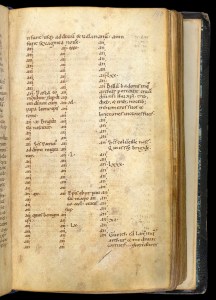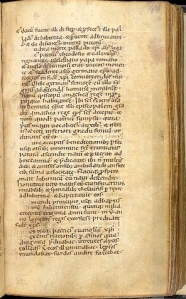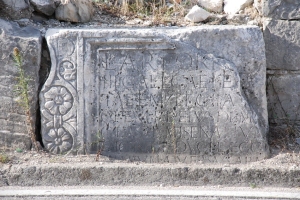After three posts that mostly dealt with the general historical background to King Arthur (2004, dir. Antoine Fuqua, screenplay by David Franzoni), it’s time to actually look at the plot, and now I’ll bring my case for indicting David Franzoni for crimes against geography and assault with a pseudohistorical weapon.
The Northern Frontier
The film takes place in northern Britain, along Hadrian’s Wall. Arthur and his men seem to be stationed at one of the forts dotted along Hadrian’s Wall, which marked the legal extent of Roman Britain. Hadrian’s Wall is the most famous example of a Roman limes, a boundary wall used to separate the Romans from people they did not directly rule. There are at least ten of these structures known, including two that run along the Danube, one in Arabia, and one in Libya. Contrary to popular imagination, however, a limes was not really a towering defensive position like the Great Wall of China; the surviving remains of Hadrian’s Wall are actually quite low to the ground and it would not have been hard for a stealthy band of northern Britons to scale it unseen. The purpose of Hadrian’s Wall was more likely to act as a boundary check-point, controlling the movement of goods and peoples across the boundary and to demonstrate to non-Roman peoples the superiority of Roman engineering (and therefore by extension, military) skills. It would have slowed down a formal invasion and allowed Roman soldiers to send an alarm to one of the more heavily fortified forts along the wall, where substantial garrisons were situated.
Substantial scenes take place at one of the forts. The fort is never explicitly identified in the film, but in Lancelot’s closing voice-over, he identifies the final fight there as being the battle of Badon Hill (a point I had overlooked in my previous post about Germanus—my apologies), so I’m going to call this fort Badon, even though that makes absolutely no sense. Placing Badon on Hadrian’s Wall makes about as much sense as saying that the battle of New Orleans took place in New Jersey, since most of the sites that have been proposed for Badon are well to the south. Some people have suggested that the second battle mentioned by Gildas, the battle of Camlann, took place at Camboglanna, one of the forts on Hadrian’s Wall, but I’ve yet to see any serious argument that Badon was on or near the Wall.
At the start of the film, the antagonists are the indigenous natives of northern Briton. Historically these people have been referred to as the Picts. But the film instead calls them the ‘Woads’, reportedly because during the script read-through, someone suggested ‘Woads’ sounded cooler. Sigh.
We know the Woads are badasses because right at the start of the film they ambush the carriage bringing Bishop Germanus to Badon and get themselves entirely killed (except for one lucky guy that Arthur decides to spare for no clear reason). So let’s think about this. The Woads live north of the Wall, a heavily protected military frontier. Badon is just south of the Wall. Germanus is traveling up to Badon from the south. Do you notice a problem here? How did the Woads get over the Wall to launch an attack so far to the south? This is typical of the film’s approach to geographical issues, which is that they basically don’t matter at all. (Also, fun fact—carriages won’t be invented for another 1000 years, so they may as well have put Germanus in a humvee. But see Update.)
After he gets to Badon, Germanus tells Arthur that his men have to go up north of the wall and rescue Marius and his son Alecto (who should be Allectus, but we’ve already established in this blog that movies never get Roman names right. Alecto is the name of a Greek goddess), who happens to be the pope’s favorite godson somehow. Marius is an important Roman who just happens to live north of the Wall, a very long way north as it turns out. Again, let’s think about the geography. The Roman Empire is to the south of the Wall, the hated enemy Woads to the north. Why is Marius, an important Roman, living well to the north of the Wall, in enemy territory? If the Woads dislike the Romans so much, why haven’t they massacred the defenseless Marius? Apparently the Wall and its military fortresses were just randomly plopped somewhere on the British landscape with no regard for who lives where, and Marius accidentally wound up on the bad side and some of the Woads wound up on the good side.
And Then There’s the Saxons
To complicate things, the villainous Saxons have landed an invasion force three days north of the Wall and are marching south to conquer Britain. Now, historically, the Saxons began their invasion well south of the Wall, pretty much the opposite end of the whole island actually, but failing to make historical sense is pretty much a given for this film, so by this point I had mostly gotten numb to that problem. But this makes absolutely no geographical sense either. If the Saxons are invading by boat, why land themselves such a long ways to the north and then march south to a major fortification which they will have to conquer before they can then march further south to conquer Britain, when ALL THEY HAVE TO DO IS LAND THEIR INVASION FORCE SOUTH OF THE WALL?
The entire plot of this film falls apart if the leader of the bad guys (or anyone in the audience) just bothers to look at a goddam map. This is like making a film where Canada decides to invade the United States via Mexico. You see how absurd that is? Canadians are too polite to invade anyone. But David Franzoni won’t let little things like geography or manners stop his plot.
The villainous Saxons are led by the even more villainous Saxon leader Cerdic (Stellan Skarsgård). We know the Saxons are villainous because they rape women. We know Cerdic is even more villainous because raping woman is too nice for him. He wants his men to kill everyone instead because he doesn’t want them to produce weak children. So he kills his man for being nice enough to rape someone. (Why is it that Hollywood bad guys have to demonstrate their badguyness by killing the bad guys who work for them? Sure, it establishes a hierarchy of badguyness with the main villain at the top, but it seems to me that it would also be a motivation for his men to run away or try to kill him.) Cerdic’s son, Cynric (Til Schweiger) challenges him, and Cerdic once again demonstrates his badguyness by telling Cynric that the next time he challenges his old man, he better have a sword in his hand. Unfortunately, what this really establishes for the audience is that Cynric, who logically ought to be number two on the badguyness hierarchy, is really just a wuss.
But it does create a situation where the Woads turn out to not be such bad guys at all. They’re actually good guys who just happen to like launching sneak attacks over a heavily fortified frontier to massacre innocent traveling bishops.
The Woads’ lack of genuine badguyness is discovered when Arthur and his men get to Marius’ villa up north. Marius turns out to be an asshole. We know he’s an asshole because he doesn’t want to leave, despite the Saxon army heading his way, and because he’s confiscating all his peasants’ grain and letting them starve. Arthur tells the peasants they’re all free, because Arthur is a good guy and freedom is a good thing. The basic purpose here is to recycle the cliché of the good guy being ordered to rescue someone useless and stupid because that makes the meaningless death of most of the good guys more poignant somehow. The movie’s basically a shitty remake of Escape from New York with Arthur as a more freedom-loving Snake Plissken.
Arthur notices that a couple of Christian priests are bricking up a building, so naturally he insists on forcing his way in, despite the priests claiming this is a holy place. What he discovers instead is that the priests have been torturing Woads there, including a cute moppet whose primary purpose is to remind Arthur of his own unhappy childhood, and Guinevere (Keira Knightley), who eventually turns out to be the daughter of Arthur’s archnemesis the Woad leader Merlin (Stephen Dillane). As usual, this makes no sense. Why are Christian priests torturing people and claiming that the torture chamber is a holy place? Given that the film has already established a contrast between the good British Christianity of Arthur and Pelagius and the bad Roman Christianity of Germanus, making these British Christians horrible people just undermines the dichotomy Franzoni was trying to establish and leaves Arthur as the only Christian who believes anything nice, because freedom and not torturing people are nice.
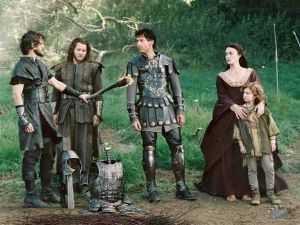
King Arthur, or SCA event? King Arthur, because if it were an SCA event, the outfits would be more authentic.
The geography, by the way, has gotten worse. Arthur discovers that the Saxons are to the south of them (still north of the Wall, but south of them). They landed three days’ north of the Wall (so apparently Marius’ villa is REALLY far north in Scotland), and have apparently just been hanging out for three days, since Arthur has gotten further north than them without them getting anywhere near the Wall. And because the Saxons are to the south, Arthur is going to have to lead Marius’ people and the rescued Woads over the mountains to the east. The major mountain range in Scotland is the Grampians, which separates the Scottish Highlands from central and southern Scotland. So evidently Marius’ villa is west of Inverness or Loch Ness, and the Saxons, who are coming from the east (having left the region around the mouth of the Rhine river), have sailed northwards around Britain and landed on the western side of Scotland, maybe around Oban or Fort William. They can’t have landed on the east side, because going eastward over the Grampians would still put Arthur’s group north of the Saxons. So apparently Cerdic lands around Fort William, camps out for several days while planning to attack a defenseless villa, marches northeastward up the Great Glen toward the villa despite having the intention of conquering southern Britain, and then discovers that Arthur has gotten Marius out of there. So he then chases Arthur over the Grampians, with the result that Arthur gets south of the Saxons and gets back to Badon before the Saxons do.
It’s not just that the plot would fall apart if the Saxons looked at a map; the plot would fall part if David Franzoni looked at a map. Why the hell is Marius living so far into enemy territory, and why did the Saxons invade western Scotland? Why go north to go south? Because Franzoni isn’t going to let a little thing like geography get in the way of telling a not-very-good story.
After Arthur leads the defenseless peasants over the mountains and fights a battle on a frozen river (because it’s winter in Scotland, but not at Badon), Guinevere helps broker an alliance between Arthur and Merlin to fight their common enemy the Saxons. What Merlin gets out of this isn’t clear, because Arthur has a grand total of 5 men under his command, so he’s basically suckering Merlin into giving him a Woadish army when all the Woads have to do is keep out the way of the Saxons as they head south to plunder Roman Britain. The Woads, after all, are brilliant woodsmen whom even Arthur can’t catch. And instead of fighting among the forests of Scotland, which offer perfect cover for the hit-and-run guerilla tactics the Woads are so good at, and instead of using Badon as a strong defensible position that would multiply the power of his greatly outnumbered forces, Arthur decides the smart thing to do is opt for an open field battle next to the Wall. Why does anyone think this man is a skilled military leader? A ten year old with a pile of snowballs and a mound of snow to hide behind demonstrates more tactical sense than Arthur shows through most of this film.
And so the film climaxes in the Battle of What’s In Your Wallet, in which hordes of villainous Saxon barbarians charge across a smoke-filled field to fight a few brilliant horsemen who spend most of their time fighting on foot while Woadish archers, including a leather bikini clad Guinevere, fire arrows at them without ever hitting any of the good guys. I suppose in that situation being insanely outnumbered is actually sort of helpful, because the odds of hitting a good guy are small. Oh, and the Woads also have trebuchets, while the Saxons have crossbows. I’ve seen Lego battles with a greater concern for historical accuracy.
Then Arthur wins and Merlin marries him to Guinevere and the happy couple live happily ever after, and the Arthurian legends live happily ever after, and history lives happily ever after. Everyone winds up happy. But not geography. Geography can go fuck itself.
Update: In response to a question from a reader, I did a little more research into Roman transportation. I had been under the impression that while the Romans used a variety two- and four-wheeled wagons, they did not have a covered, four-wheeled person transport with a suspension system–what i would consider a carriage. However, it turns out that an archaeologist working in Bulgaria in the 1960s did uncover the remains of what he reconstructed to be exactly such a vehicle. This is literally the only known example of such a vehicle, but it did exist, and the vehicle used in King Arthur looks not unlike a reconstruction of it in a Cologne museum. So I have to give the film credit for getting that detail basically right, although whether such a vehicle was still in use in the 5th century and on the edge of the Empire is probably debatable.
Want to Know More?
No, you don’t. But if you really must, King Arthuris available on Amazon.
Also, think about picking up this: Britain and Ireland Wall Map (tubed) British Isles

